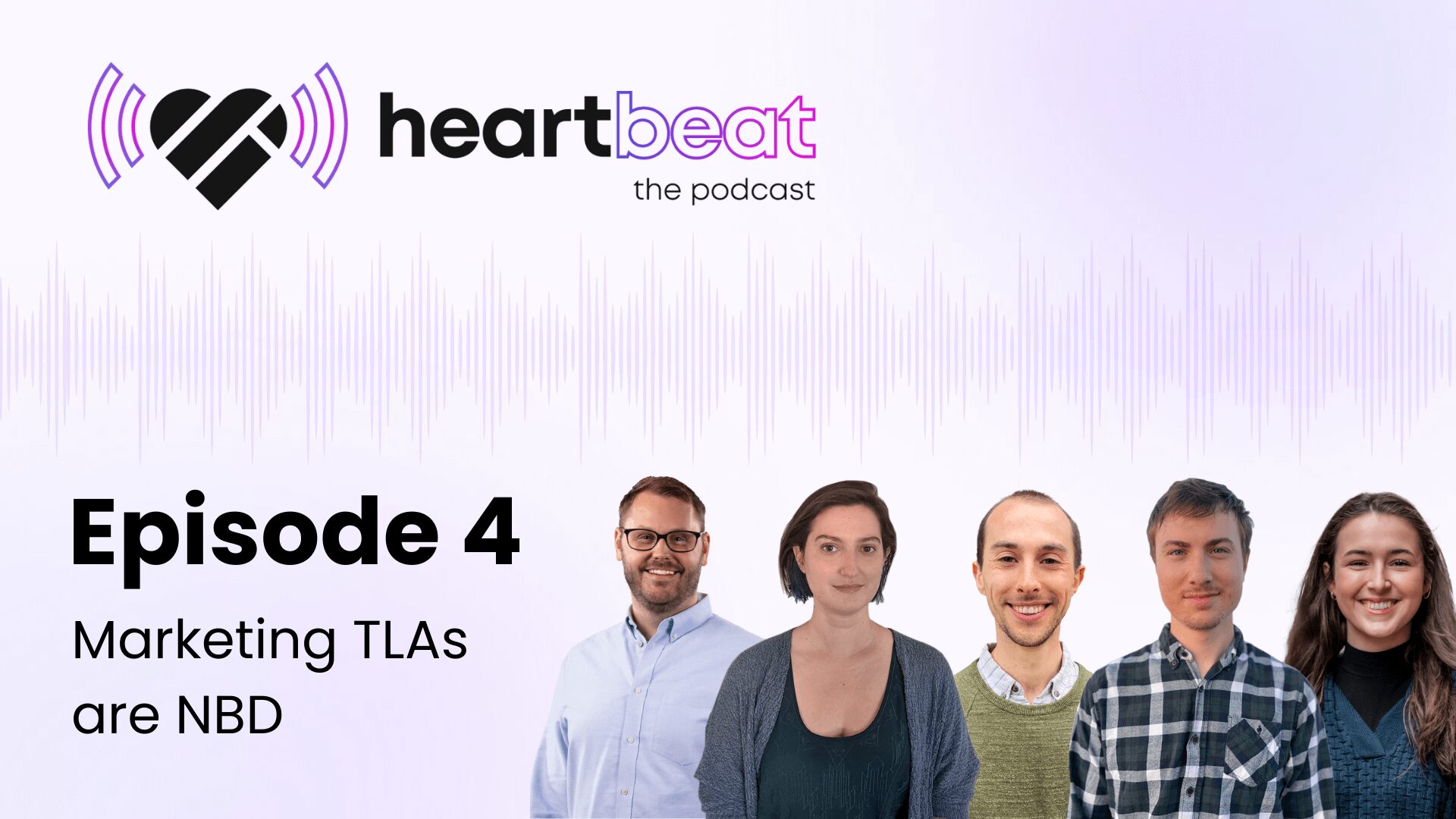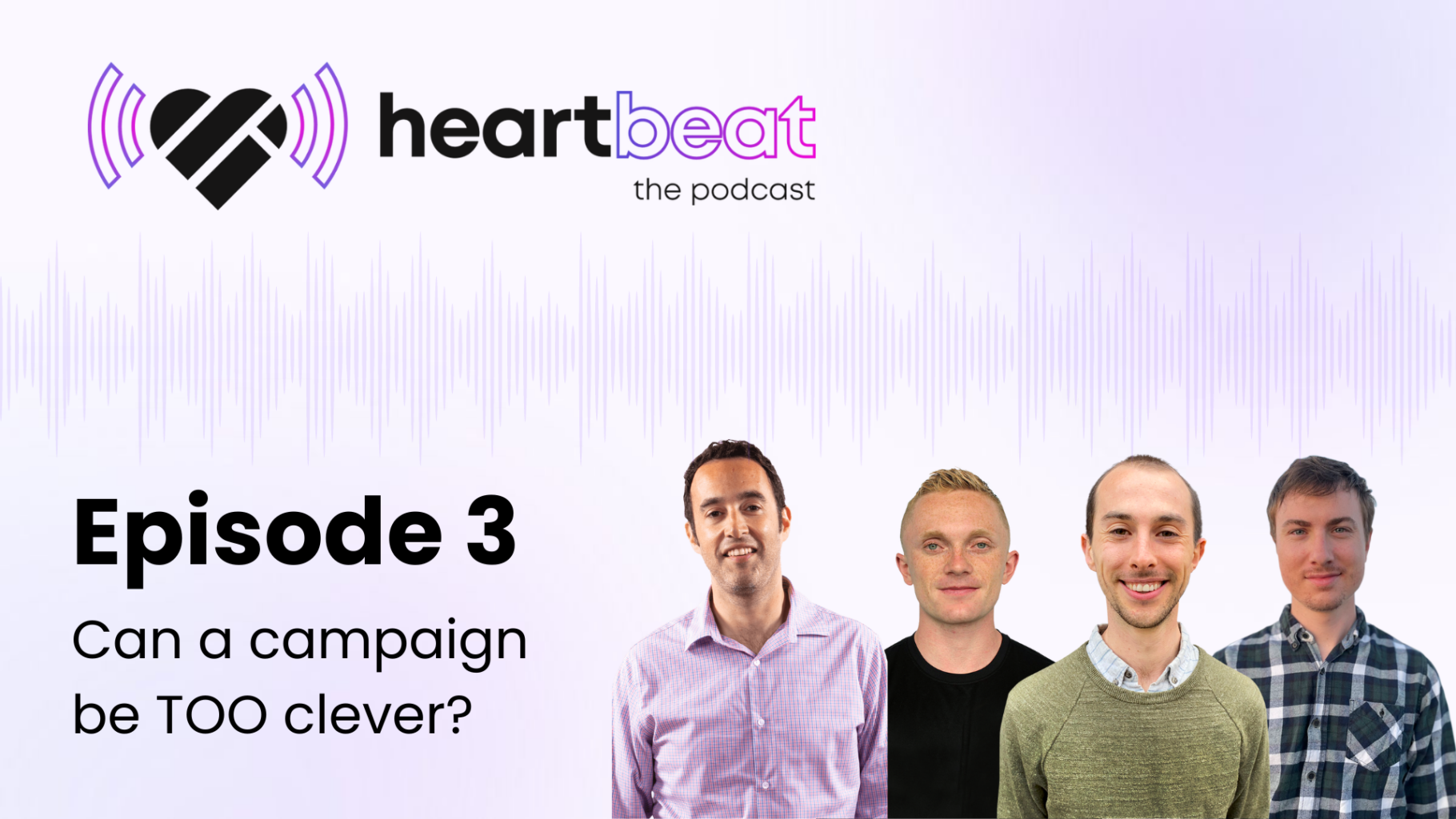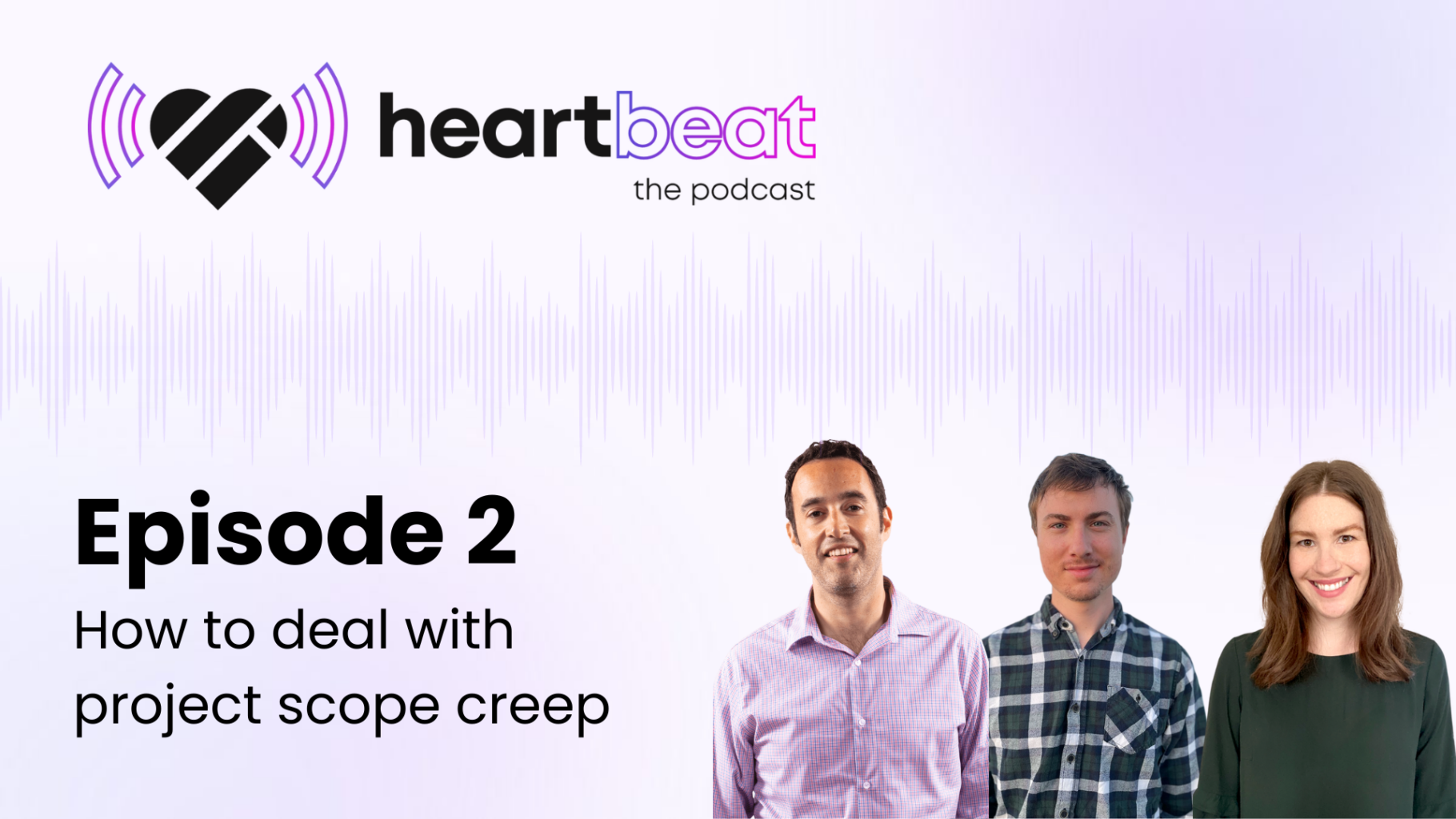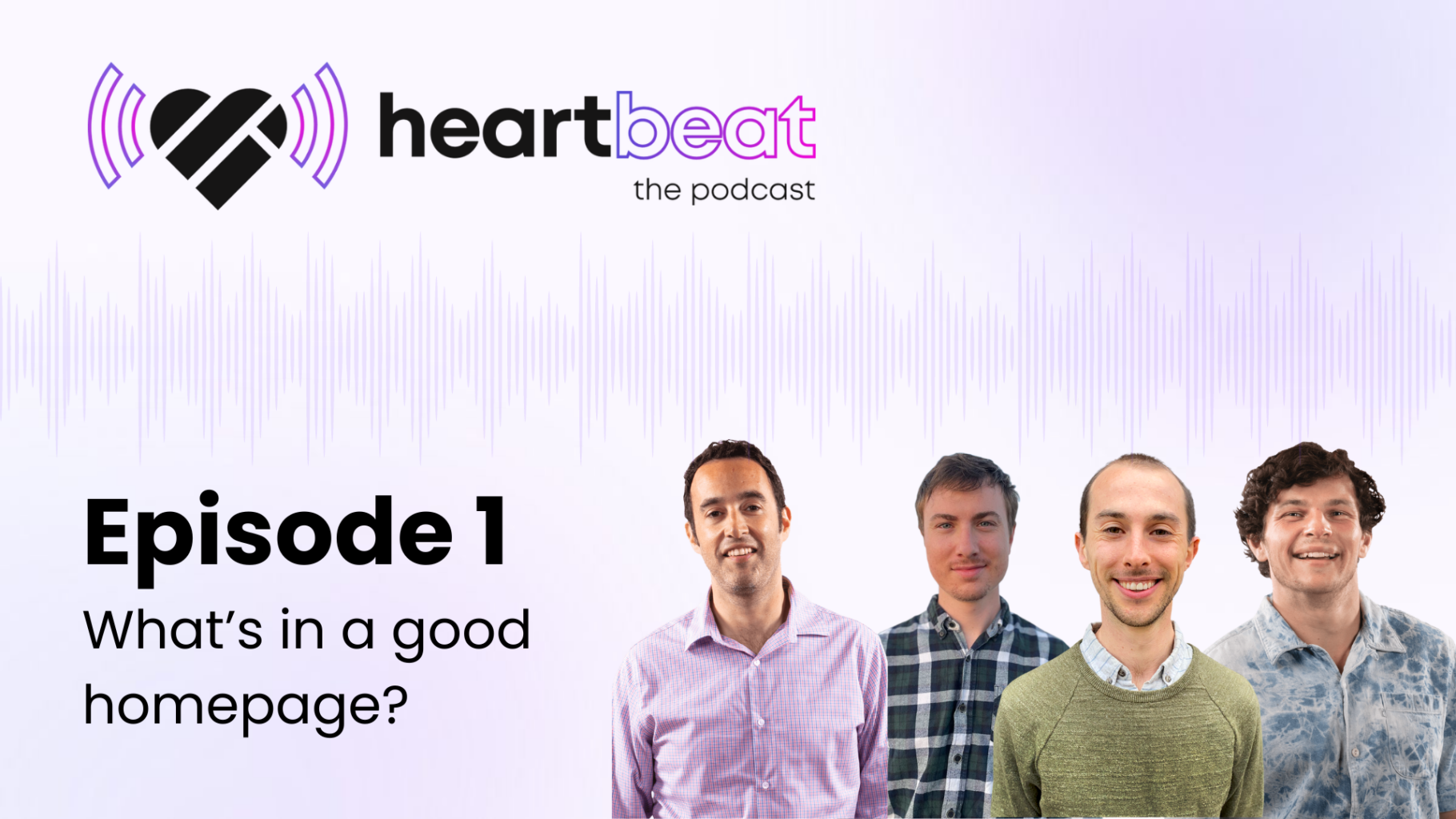In the fast-paced world of marketing, acronyms are like currency. They can save time, add a touch of professionalism, or leave everyone scratching their heads. In a recent episode of The Heartbeat Podcast by Digital Impulse, the team dove into the world of marketing acronyms and the art of using them effectively.
The podcast kicks off with a discussion among Conor, Chapin, Roland, Maggie, and Mary, exploring the nuances and challenges of dropping acronyms in client meetings. From feeling like a marketing pro to accidentally causing confusion, the team shares their experiences and strategies for navigating acronym-laden conversations.
Chapin shares a clever tactic he uses when faced with unfamiliar acronyms: ChatGPT. By setting up a digital marketing chat, he can quickly get context-specific explanations, saving face and keeping the conversation flowing.
The team then embarks on a lightning round, testing each other’s knowledge of common marketing acronyms. From the familiar “CTA” (Call to Action) to the more obscure “CPM” (Cost Per Mille), they showcase both their expertise and occasional stumbles, proving that even seasoned marketers can get tripped up.
As the conversation unfolds, one thing becomes clear: while acronyms can streamline communication, they can also create barriers if not used judiciously. Mary points out the importance of reading the room and adjusting your language to match the client’s level of familiarity.
Despite the potential pitfalls, acronyms remain a staple of marketing discourse. They serve as shorthand for complex concepts and facilitate efficient communication within the industry. However, striking the right balance between clarity and brevity is key to effective communication.
Whether you’re a seasoned marketer or just starting out, understanding and mastering marketing acronyms is essential. By staying informed, reading the room, and knowing when to spell it out versus when to drop the acronym, you can navigate client conversations with confidence and clarity. And if all else fails, there’s always Google to lend a helping hand.
Transcript below:
Conor Snell: Thanks for listening to The Heartbeat Podcast by Digital Impulse. Today we’re talking marketing acronyms, you know, the little three-letter toss-outs that might make you look smart in front of a client, or…
Chapin Bennett: Or dumb.
CS: …or might just make you look dumb or introduces an awkward moment in a meeting. So yeah, I’m just excited to get into it. I’m Conor, I’m here with a quad of guests. We’ll go around the room—Roland, starting with you.
Roland Davin: Hi, I’m Roland Davin, Director of Marketing Services here.
Maggie Jackson: I’m Maggie Jackson, I’m an Account Associate here at DI.
CB: I’m Chapin Bennett. I am the COO at Digital Impulse.
Mary Fonvielle: And I’m Mary Fondle, Digital Campaign’s graduate state, Digital Impulse.
CS: Awesome. Thanks for joining everyone today. First things first, when we talk about marketing acronyms, right? We use these all the time in meetings. What’s your feeling when you have that moment on a call with a client where you say a three-letter acronym, and they’re like, “I have no idea what you’re talking about.” How does that make you feel?
CB: They have no idea what we’re talking about?
CS: They have no idea that acronym you’ve just used.
CB: I feel like it’s typically the reverse.
CS: Really?
CB: Yeah.
CS: So you have the client use an acronym and you’re like, “You have no idea what you’re talking about.”
CB: And I’m like, “Google, goole google!” Yeah.
CS: What do you do in that situation?
CB: I have actually found ChatGPT is extremely valuable for that. Yeah, it works very like you Google it and you could get anything for a million different industries, but I set up a digital marketing chat for myself in ChatGPT. So, when I put in an acronym, it’s more likely to be a digital marketing acronym.
CS: Gotcha.
RD: It knows the context?
CB: It does. Yeah.
MF: I just put digital marketing in the Google search.
CS: Yeah, right. I always find it funny—I feel like I see, I use terms a lot and I’ll be like, “Oh, when we plan your CTA for your website, we got to think about this.” And the client’s like “Hold up. What are you talking about?” And, like, this is a pretty foundational piece of the puzzle. So I’m most curious when those come up.
Have you guys found that there’s any particular… I feel like marketing acronyms are more common, but there’s some website, like design ones that I feel like are less common. Do you guys feel like there’s one that’s more popular to use than the others?
RD: Yeah, I mean, marketing is a riddle of them, especially in the paid side, right? Anything that’s like a cost per, right? You got your CPAs, your CPMs, CPAs, and you have cost per different types of leads.
You can go down the funnel, everything, you know, CPQLs, and depending on the client, they all use different terminologies. Some folks, “CPA is this and our CPL is that.” Well, hold on. You differentiate between your CPA and your CPL? What does that mean? Because there’s an universal definition. At least with CPC, click is a click.
CS: Yeah. Maggie, what do you think?
MJ: You know, from the terms you guys have already used, I’m pretty familiar with which I’m happy, but also it does get confusing. I joined a meeting and I literally had to pull up a whole dictionary afterwards and talk with a few new other employees here. So my, I think the one that I see the most is CTA so far.
CS: Yeah.
CB: We should, I think we should give a little context for Maggie. So, this is officially her third day here. Fresh out of college, right? So, this is, this is probably a challenging one for you, right? But I give Maggie a grandiose speech on her first day about just asking a million questions and not being shy about jumping in. So we are putting you to the test right now.
MJ: I’m ready.
CS: All right. Well, I think that’s a good place to, you mentioned, Roland like a bunch of different three-letter acronyms. Let’s do a quick lightning round. And I’ll go around the room and I’ll give you one and we’ll see if you can guess what it or if you know what it means.
CB: Okay.
CS: Mary, we’ll start with you: KPI.
MF: Key performance indicator.
CS: Correct. Roland: CTR.
RD: Click through rate.
CS: Maggie: CPM.
MJ: Uh, cost per margin?
CS: Close.
MJ: It’s cost per… cost per metric?
CS: Again, closer.
MJ: Uh, cost per measure?
CS: You’re right there!
RD: It might be the hardest one!
CS: It’s kind of a trick question because the “M” doesn’t stand for the word that we use to describe it.
CB: Yeah that’s tricky.
MF: Yeah.
MJ: Oh, that’s mean.
RD: It is mean!
CS: CMP is “cost per thousand.”
MJ: Oh, okay.
CS: The M is “mille.”
MF: So technically, because it’s Latin for a thousand. It’s per mil.
MJ: I took Spanish.
CS: Chapin, UX, UI.
CB: User experience, user interface.
CS: Perfect. I always think the UX is… you do not spell experience for the X! Mary: W-O-M.
MF: I’ve never heard that one.
CS: Yeah?
CB: I don’t know.
MJ: Word of mouth!
MF: Oh… I was thinking, like, marketing contacts. We don’t speak
CS: Yeah, only digital. Roland: KGH.
RD: K-H-G? That sounds like a thing that you would have just made up.
CB: Key? Key something?
RD: I have no idea. Hit me with it.
CS: It is actually made up.
RD: Oh, no, no. It’s made up. I was like “What K-H-G works?”
CS: Maggie, you’ll give you another similar one: CPA.
MJ: Cost-per-action.
CS: Yeah!
CB: Yeah.
CS: Yeah. I see “action” or “acquisition,” but I think that’s correct.
CB: Yeah.
CS: Roland: I think there’s the hardest one—oh, no, sorry. Chapin, hardest one: API.
CB: API. Wow. I know what an API is. P… I have no idea what the A is. I have no idea what the P is. I, interface?
CS: Yes.
CB: Okay. We’re working backwards. Boy. Protocol?
CS: Nope.
CB: Damn. I need a little help here. Phone a friend!
CS: It’s funny because we use this all the time when we talk to clients, but I’ve never thought of is, and I’ve never really had any idea.
CB: I literally have no idea.
RD: Is A “application?”
CS: Yes.
CB: Oh, yeah. That makes a ton of sounds. Okay.
MJ: Process?
CS: No.
RD: I actually thought it was “application protocol interface,” and so when Conor said it wasn’t…
MF: I thought it was, too.
RD: Uh-oh.
CS: I’ve seen program interface.
CB: Oh! Yeah. Okay. That one actually makes sense.
MF: That might be another interchangeable one.
CS: Yeah. I think so.
CB: That’s very funny. I’ve never even thought about what that means. And I’ve used that a thousand times.
MF: Well, it’s like, like, the, do you all know what USB stands for? Because it sounds fake to me.
CS: It’s like “universal serial bus?”
MF: I think so.
CS: Yeah. But bus is like a, uh, rando tech word that I’ve never used in the other context.
MF: Exactly.
CS: You know what’s ironic that I found is the acronym that takes… the word itself is shorter than the acronym in terms of syllables? Is WWW.
RD: Dub dub dub.
CS: “World-wide web” is less syllables than saying WWW.
RD: That’s why you ended up having to say “dub dub dub” instead of WWW.
CS: Before w close the quiz, you guys all know what WWW means, right?
So I think there is a tendency when you talk with clients to toss out some of these acronyms. And I think sometimes people do it to sound smart. I think other times they’re like, “this is a language we’re speaking.” You know, you don’t want to get caught off guard if a client uses one that you don’t know.
How do you know the right time? Do you just like wait for the client to use them first or do you default to like, “I’m going to say the full thing before I say the acronym?”
MF: You know, for me, I try to find a balance, especially with new clients. You kind of have to, you know, you start out maybe spelling things out a little bit more and, you know, giving the definitions before going into acronyms later. And you can kind of feel out to me like over time like, oh, if I say CTA is the client, I don’t know what I talk, I’m talking about order I need to spell it out and continue to say call to action.
CS: Yeah.
RD: Yeah. Well, I also think that for me, I do the exact same thing that Mary just described, but I think even sometimes if they don’t know what a CTA is, “call to action” isn’t even necessarily self-evident, right? I mean, there are some terms in marketing that we have these acronyms that describe a concept that even itself isn’t clear, right? Cost per mille, it’s not clear, right?
And for some people, it’s not even intuitive why you would care call to action. What does that mean, exactly? So I’m going to find myself describing the concept to describe this term, and then using the acronym later.
CS: Totally. Call to action, I could see someone confusing with like a phone call? You know what I mean?
CB: Totally.
MF: Yeah.
CS: Even CPM, if you don’t know that means thousand, I could see easily someone being like “cost per million,” which is not the same as totally different, you know?
RD: That’s a thousand?
CS: Yeah. So are there any new ones we should add to the lexicon?
MF: I’m curious as to what the three letter acronyms coming out of AI will be.
CB: I was going to say the exact same thing.
MF: There’s going to be so many, right?
RD: There’s going to be so many.
CS: I mean, GPT. What does GPT’ stand for?
RD: Do you remember?
MF: I have no idea.
CB: I already told you guys. I’m the one that’s always Google.
RD: I pulled up a sentence or two that I wrote earlier today that I was trying to think of the pitfalls of using acronyms and certain contexts that I’ve heard them in that I just thought “As a marketer, this sometimes makes my heart sink when I hear clients say something like this.”
Because they can, the context around a really important idea is encapsulated in a three-letter acronym and you don’t know what that thing means.
For example, I wrote down, look, you’ll get fired for just chasing CPMs these days in your DSPs. Some of these SSPs are out there just selling snake oil without a DMP or dead in the water. Since ITP and DNT, you need a CDP for your FPD and then the other antiquated technique for measuring CLV is DOA.
All right!
CS: That’s when I shut my computer, like “stop talking.”
RD: Anyone who said that would obviously be a total jerk. There are times where I’ve had someone say the entire meaning of the idea hung on this acronym and what they were saying was obviously important and I’m playing that catch-up game. Like “Oh no! Can I figure out what this is? So I can understand what they’re trying to say.”
But there’s so many acronyms now that… that was all like a programmatic and data focused and cookie focused, which is kind of niche. But man, you find yourself in a world that you’re just not quite familiar with. I was thinking of the AI thing, that made me think of that sentence.
CB: Well, totally. We work with so many different types of companies, industries and verticals like that have so many specific unique ones. We work with so many manufacturing companies that just are throwing out completely random ones that are so normal.
MF: Oh, manufacturing it its own animal when it comes to acronyms. Yeah. I worked in manufacturing for the housing industry and their big event every year is the International Builder Show, which the acronym there is, IBS. So, all of a sudden, we would talk about having to prep for IBS.
CS: That’s actually really funny. Yeah, I’m sure there’re some double-meaning ones that for the wrong person, in the wrong context, they’d be like “what are you talking about?”
So, overall, I mean, I use acronyms all the time for marketing, especially. I think a lot of the clients who work with know what they are and if they don’t, I just have to double back and explain. Sometimes, if I myself having to Google on a call, like “what did this person just say?”
Overall, do you guys think we should lean more into those kind of time-saving concepts? Or would it be better to just kind of like spell out what we’re talking about to begin with?
MF: It just comes down to a “read the room” type situation. You’re just going to have clients who just have no idea what those terms mean and it doesn’t make sense to continue using them. It just kind of makes you sound like you’re trying to be arrogant. But if you can get the clients that actually do understand what those acronyms are, then you’re speaking their language essentially. And I think your points come across more easily.
CB: Yeah. I agree. I feel like there’s a tier of standard acronyms that within our industry that pretty much everybody knows and can piece together, and then there’s the tier two of like, “Alright, you’re trying a little too hard right now.”
MF: Yeah, exactly.
RD: One thing I think is, you know, sometimes I have this incident, this is kind of burnt into my memory. I was on with the VP of Marketing and they didn’t know what CPC was. And I thought they were hazing me.
MF: Yeah.
RD: You know? And that moment, I don’t think I’ll forget that. Right? There’s certain moments where there are things that you just need to know. Right? Maggie, it’s day 3! Maggie knows CPC, don’t you?
MJ: Cost per click.
RD: Thanks. You could be VP of Marketing just by knowing acronyms!
MJ: But here’s the thing: I learned about these in school.
CS: Did you really?
MJ: It was very whiteboard even. My professor writing it out being, “You need to know these moving forward within your career.” So that’s why it’s ingrained in my brain.
CB: Well, I was going to say it’s actually, so I’m typically more operational from day to day, right? So I think it’s actually a little bit of a disadvantage. Like younger people, people who are in the platforms all day kind of have a leg up on these marketing directors and executives because they’re actually working with them. So somebody high up could look like a real fool really quickly because they don’t understand them, but they’re not really using them constantly. So it’s a little unfair.
CS: Yeah, I agree. I think there’s definitely like a line to walk of like, “I need to know some basic ones so I don’t look like an idiot, but I also need to not in and data client with all these terms. They have no idea what they are.” And I think Mary, you make a good point of like, “You just got to read the room” I actually like to let them use them first and then use them myself. But I feel like I tend to lean more toward just saying “call to action” or “cost per click,” like just using the term to begin with.
RD: Definitely. Definitely agree.
MF: I will say my sort of litmus test when I’m talking to a salesperson who’s trying to like, really hard to sell me on some sort of like media placement or something like that. I will always ask “what sort of CPC is, what sort of CTRs are you seeing?” If they can’t answer and they obviously are like trying to like either quickly Google or trying to off play like, “Oh yeah, we know what that is.” That’s when I know that you all don’t know what you’re talking about.
CS: Yeah. It’s like a fool detector test for sure. Or if you want to just turn away salesmen really hard and you’re trying to quiz them.
MF: Yeah.
CS: Awesome. I mean, I think this is core to our ability to just like navigate tricky client communications. You got to be able to read the room and just like adjust.
I think our advice is like keep your eyes and ears open. That’s kind of the general rule of thumb for any client communication and if they use acronyms, go for it. I mean, if the door is open then I’d say show what you know and flex a little bit but don’t alienate people with your dumb acronyms if you don’t have to.
MF: Absolutely. I think if you can speak their language then that’s going to be the biggest part about good client interactions.
CS: Yeah.
RD: What do you think are your top three acronyms to know? Someone’s coming in. It’s your third day. You got to know these.
CS: I would say CTA. Call to action.
CB: CTA was the first one that came to me. Definitely.
CS: CPA or CPC. Some kind of measurement and then maybe like…
MF: I would argue KPI has become sort of a universal one you should know
CB: Those three.
MF: Yeah.
CB: That’s a good one.
CS: Yeah. Well, I would say we should make a dictionary but there’s about a billion articles online. They’re just listicles. So, I guess refer to those.
All right. Thanks to the team for joining us.
It was a good discussion and if you’re out there and you need help wrangling all those acronyms, let us know. We can help cut through some of the bullshit and get to those real nuggets.
Thanks everybody!
CB: Thank guys.
MJ: Thanks for having me!
CS: Later guys.
Want more insights from our experts? Subscribe to The Heartbeat Podcast by Digital Impulse wherever you get your podcasts, or click here to browse all episodes! 💜







